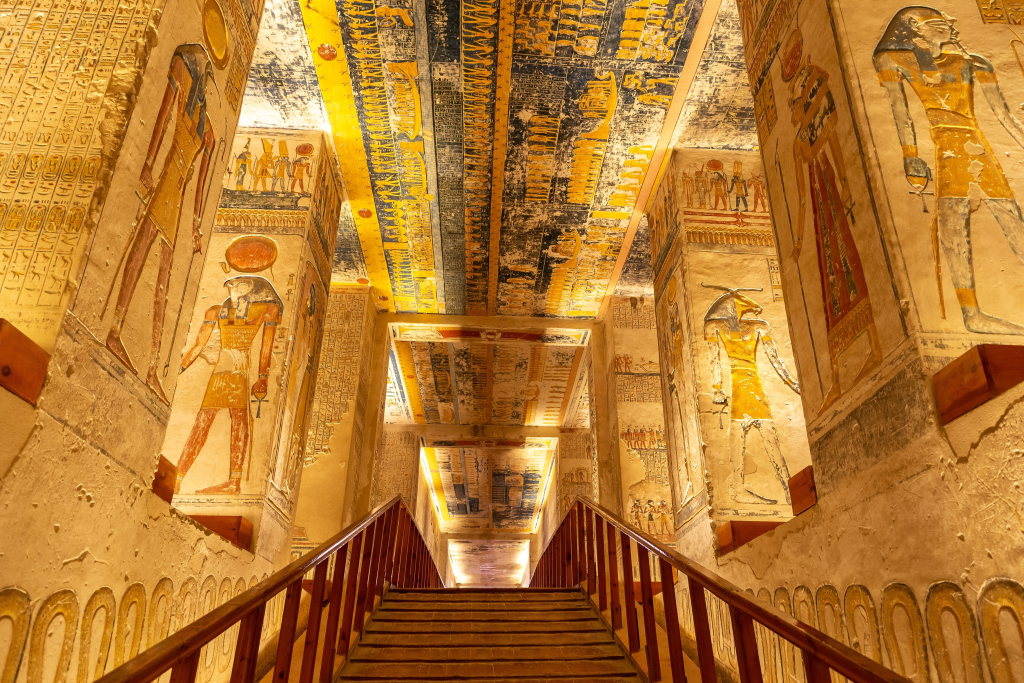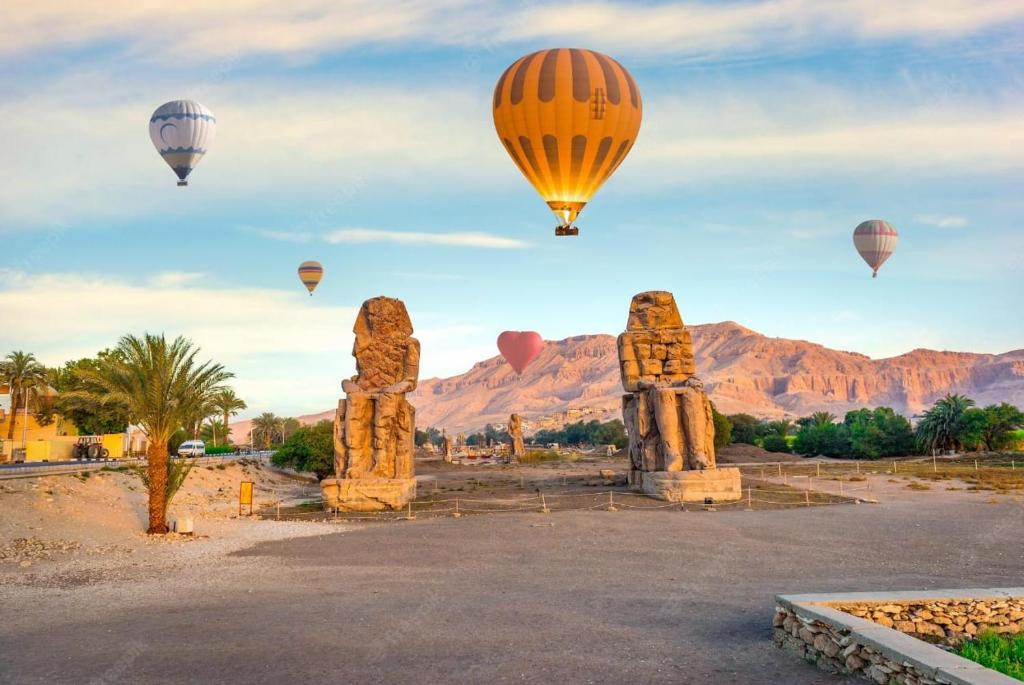For good reason, Luxor, Egypt, is frequently described to as the “greatest open-air museum in the world.” Situated on the east and west banks of the Nile River, Luxor is home to some of the most remarkable temples, tombs, and monuments of ancient Egypt. This city, known for its rich history, takes you on a journey through the height of ancient Egyptian civilization. Whether you’re a history enthusiast, an archaeology buff, or simply someone who appreciates cultural heritage, Luxor offers an endless list of fascinating activities and sights to explore.
Let’s dive into the best things to do in Luxor, Egypt.
Table of Contents
ToggleKarnak Temple Complex
Overview:
The Karnak Temple Complex is the largest religious structure ever built, and it stands as a testament to the grandeur of ancient Egypt. Located on the east bank of the Nile, Karnak is a sprawling site of temples, chapels, pylons, and obelisks. It was the center of worship for the god Amun and played a pivotal role in Egypt’s religious life for over 2,000 years.
Key Highlights:
- Great Hypostyle Hall: Probably the most recognizable feature of the Karnak complex is the Great Hypostyle Hall. The largest of its 134 enormous columns, which are stacked in 16 rows, rises to a height of 21 meters. Walking through this hall gives you a sense of the scale and magnificence of ancient Egyptian architecture.
- Sacred Lake: This large body of water was used for religious rituals and purification by the temple priests. The lake is still visible today, offering a peaceful place for reflection amid the ruins.
- Obelisks of Hatshepsut and Thutmose III: The Karnak Temple is home to towering obelisks, including the famous obelisk of Queen Hatshepsut, one of Egypt’s most prominent female pharaohs. These obelisks are not only architectural marvels but also historical artifacts inscribed with hieroglyphs that recount important events.
Why Visit:
Anyone interested in the religion or history of ancient Egypt must visit Karnak. It is a place that astounds tourists with its immense size and minute features.
Best Time to Visit:
The best time to visit Karnak Temple is early in the morning or late in the afternoon, when the crowds are thinner, and the lighting is ideal for photography.
Luxor Temple
Overview:
Located just a short distance from Karnak, Luxor Temple is another architectural masterpiece. Unlike Karnak, which was primarily a religious complex, Luxor Temple was more of a ceremonial site linked to royal power. Amenhotep III constructed it and later expanded by Ramses II, two of Egypt’s greatest pharaohs.
Key Highlights:
- Avenue of Sphinxes: The Luxor Temple is connected to Karnak Temple via the Avenue of Sphinxes, a 3-kilometer-long pathway lined with sphinx statues. Recent restorations have made this avenue walkable again, providing a grand entrance to the temple.
- Colossal Statues of Ramses II: At the temple’s entrance, you are greeted by two enormous statues of Ramses II seated on his throne. These statues exemplify the power and might of one of Egypt’s most famous rulers.
- Roman Influence: Luxor Temple also has elements from the Roman era, including a chapel dedicated to the Roman emperor Augustus. This fusion of cultures makes Luxor Temple unique, as it offers a glimpse into Egypt’s later history under Roman rule.
Why Visit:
Luxor Temple is not just a place to see ancient Egyptian art and architecture; it’s a testament to the layers of history that have shaped Egypt over millennia.
Best Time to Visit:
Visit Luxor Temple in the evening for a magical experience when the temple is illuminated, giving the statues and columns a golden glow under the night sky.
Valley of the Kings

Overview:
Situated on the west bank of the Nile, the Valley of the Kings is the last resting place of many of Egypt’s New Kingdom pharaohs, including the famous boy-king Tutankhamun. With over 60 tombs, each more intricate and elaborate than the last, the Valley of the Kings is one of the most vital archaeological sites in the world.
Key Highlights:
- Tomb of Tutankhamun: While many of the tombs in the Valley of the Kings have long been looted, the tomb of Tutankhamun was discovered almost entirely intact in 1922 by archaeologist Howard Carter. Visitors can enter the tomb and see the final resting place of Egypt’s most famous pharaoh, along with his golden sarcophagus.
- Tomb of Ramses VI: One of the most impressive tombs in the valley is that of Ramses VI, with walls and ceilings decorated with intricate hieroglyphs and scenes depicting the journey to the afterlife.
- Tomb of Seti I: This tomb is known for its size and the exceptional quality of its wall carvings and paintings. It remains one of the most visually stunning tombs in the valley.
Why Visit:
The Valley of the Kings offers a superb glimpse into ancient Egyptians’ burial practices and beliefs about the afterlife. Exploring these tombs gives you a real sense of the grandeur and mystery of Egypt’s pharaonic era.
Best Time to Visit:
Visit the Valley of the Kings early in the morning to avoid the heat, especially during summer.
Temple of Hatshepsut
Overview:
The Mortuary Temple of Hatshepsut, located at Deir el-Bahari, is one of the most unique temples in Egypt. Built for one of Egypt’s few female pharaohs, Queen Hatshepsut, this terraced temple is a masterpiece of ancient architecture, blending seamlessly into the surrounding cliffs.
Key Highlights:
- Architectural Design: The temple’s unique design features three large terraces connected by ramps, with the temple blending into the natural rock cliffs behind it. This harmony between nature and architecture makes it one of the most stunning temples in Luxor.
- Statues of Hatshepsut: Throughout the temple, you’ll find statues of Hatshepsut dressed in traditional pharaoh attire, complete with a false beard. This symbolic move emphasized her role as a legitimate ruler in a male-dominated society.
- Chapel of Anubis: Within the temple complex, the chapel dedicated to the god Anubis is beautifully decorated with reliefs and hieroglyphs, showcasing the importance of this deity in funerary practices.
Why Visit:
Hatshepsut’s Temple stands as a symbol of her reign and the architectural advancements made during her time. Its design is truly one-of-a-kind in the ancient world.
Best Time to Visit:
Visit Hatshepsut’s Temple in the late afternoon when the sun illuminates the cliffs and temple, creating an unforgettable visual spectacle.
Colossi of Memnon
Overview:
The Colossi of Memnon are two massive stone statues of Pharaoh Amenhotep III that have stood at the entrance to his mortuary temple for over 3,000 years. Although the temple is mostly in ruins today, the two colossal statues symbolize ancient Egyptian grandeur.
Key Highlights:
- Statues: Each statue stands about 18 meters tall and weighs around 720 tons, making them some of the largest statues from the ancient world. The colossi once guarded the entrance to Amenhotep III’s temple, one of the largest ever built in Egypt.
- Legend of the Singing Statues: In ancient times, one of the statues was said to “sing” at dawn, a phenomenon believed to be caused by the expansion of the stone due to the sun’s heat. This legend drew travelers from around the ancient world, including the Roman emperor Hadrian.
Why Visit:
The Colossi of Memnon offers a quick yet awe-inspiring stop along the west bank of the Nile. These towering statues are a must-see for their sheer size and historical significance.
Best Time to Visit:
The Colossi of Memnon are free to visit and can be seen anytime. Early mornings or late afternoons are ideal for photography.
Luxor Museum
Overview:
Tourists often overlook the Luxor Museum, but it is one of the best places to see ancient artifacts from the city. The museum is beautifully curated, focusing on quality rather than quantity, showcasing some of the finest pieces of Egyptian art and history.
Key Highlights:
- Mummy of Ramses I: One of the most important exhibits at the museum is the mummy of Ramses I, founder of the 19th Dynasty, which was repatriated to Egypt from North America in 2003.
- Statue of Thutmose III: The museum is home to a beautifully preserved statue of Thutmose III, often considered one of Egypt’s greatest warrior pharaohs.
- Akhenaten Room: A special section is dedicated to Akhenaten, the pharaoh known for his religious revolution, where visitors can see statues and carvings from his reign.
Why Visit:
The Luxor Museum provides a more intimate experience than the sprawling temples and tombs. It’s an excellent place to gain a deeper understanding of ancient Egypt’s artistry and craftsmanship.
Best Time to Visit:
The museum is usually less crowded, so it can be visited at any time of day, though early afternoons are often the quietest.
Hot Air Balloon Ride Over the West Bank

Overview:
Consider going over Luxor’s west bank in a hot air balloon for an adventure that will last a lifetime. You’ll glide over some of the most famous sites in ancient Egypt as the sun rises, such as the Colossi of Memnon, the Temple of Hatshepsut, and the Valley of the Kings.
Key Highlights:
- Panoramic Views: From the air, you’ll get a bird’s-eye view of Luxor’s temples, tombs, and the lush green Nile valley, contrasted with the barren desert beyond.
- Sunrise Experience: The hot air balloon rides typically occur at sunrise, offering breathtaking views as the early morning light illuminates the ancient monuments.
Why Visit:
A hot air balloon ride is one of the most unique ways to experience the wonders of Luxor. It offers a different perspective on the city and its surroundings that you won’t get from the ground.
Best Time to Visit:
Hot air balloon rides are only offered at sunrise, so book your experience in advance to ensure clear skies and good weather.
Medinet Habu
Overview:
Medinet Habu, located on the west bank of the Nile, is the mortuary temple of Ramses III, one of the most powerful and successful pharaohs of the New Kingdom. Although tourists often overlook this temple, it’s one of the best-preserved temples in Luxor, with stunning reliefs depicting Ramses III’s military victories.
Key Highlights:
- Reliefs of Ramses III’s Military Campaigns: The walls of Medinet Habu are adorned with detailed reliefs that recount the military victories of Ramses III, including his famous battle against the Sea Peoples.
- Size and Preservation: Medinet Habu is one of Luxor’s largest and best-preserved temples. Its size and the quality of its carvings make it a site worth exploring in detail.
Why Visit:
Medinet Habu is often quieter than other temples in Luxor, making it a peaceful spot to explore ancient Egyptian history without the crowds.
Best Time to Visit:
When the sun is setting and the temple is bathed in a gentle glow, visit Medinet Habu in the late afternoon.
Conclusion
Egypt’s Luxor is a city unlike any other, providing a window into the opulence of ancient Egyptian culture. From the towering columns of Karnak to the intricately decorated tombs of the Valley of the Kings, Luxor is a place where history comes alive. Whether wandering through the colossal temples, sailing along the Nile, or taking in the view from a hot air balloon, there’s no shortage of incredible things to do in Luxor.
Luxor is a place that both tourists and history buffs should visit in order to fully understand it. Plan your visit carefully, explore these iconic sites, and immerse yourself in the fascinating world of ancient Egypt.
